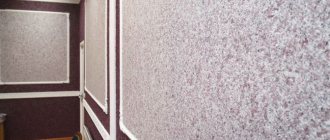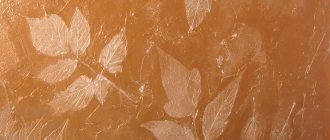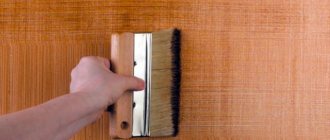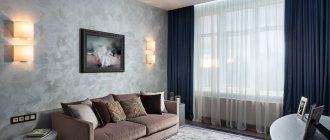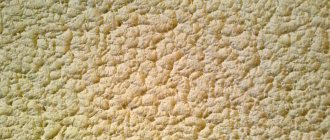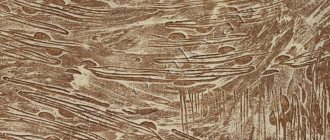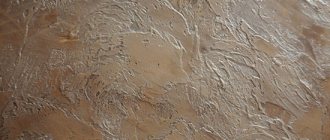In today's article we will tell you the topic of choosing decor for renovating rooms in your apartment or house. If you are faced with the problem of choosing decor for renovating rooms and are wondering whether to choose decorative plaster or wallpaper, then in this article we will tell you what the difference is between these finishing materials and what is best to choose to start the renovation.
Of course, many who are wondering about the choice do not fully understand what decorative plaster is and how it differs from wallpaper.
Let's take a quick look at two finishing options, wallpaper and decorative plaster.
Types of wallpaper, their pros and cons
Wallpaper is a fairly classic material for interior decoration. Surely you know that wallpapers are different and differ not only in design, but also in the structure itself. For example, wallpaper comes in different types.
Types of wallpaper:
- paper wallpaper;
- vinyl wallpapers;
- non-woven wallpaper;
- liquid wallpaper;
- others.
Each of these types of wallpaper is quite interesting. The differences lie in both appearance and composition. Wallpapers vary greatly in price, which is why they are so popular. Everyone can choose for themselves exactly those wallpapers that they can afford. Let's say that those who want to wallpaper the walls in their country house will choose wallpaper that is cheaper, and those who are going to do renovations in their apartment will choose wallpaper that is more expensive.
Many wallpapers differ from each other according to the type of interior. Today, the manufacturer divides wallpaper into different types.
Wallpapers are divided into:
- for a children's room;
- for the bedroom;
- for the hall;
- for kitchen;
- universal.
If you do not have a rich imagination and cannot imagine how to choose the right wallpaper for a particular room, then you can easily choose the wallpaper according to its purpose and paste the walls of the nursery with bright, cheerful wallpaper, and the hall with wallpaper with a rich texture.
The advantages of wallpaper are that they are warm and soft, while they hide minor imperfections in your walls.
Among the disadvantages are cheap wallpapers, which are quite difficult to glue and which quickly fade in the sun and generally look bad.
Liquid wallpaper
Fundamentally excellent material. It is a dry mixture containing the following ingredients:
- adhesive composition;
- dyes;
- cellulose and cotton fibers.
Before use, the composition is diluted with water and then evenly applied to the walls. In addition to ease of use, other advantages of the material can be noted:
- absence of joints, which are inevitable when using paper rolls;
- static and fire resistance;
- high environmental friendliness.
But there are also disadvantages:
- If liquid wallpaper is planned in the bathroom or kitchen, you will also have to apply a layer of colorless varnish on top of it. This will cause the material to lose its original positive breathability.
- A heavily contaminated area can be torn off the wall and a fresh layer can be rolled in its place. But it is possible that the new mixture will differ in color from the old one, especially if there was a lot of smoking or a stove in the room. It is because of the difficulties in care that this species often receives negative reviews from people.
Types of decorative plaster, their pros and cons
Decorative plaster is a relatively new material. Of course, the plaster itself is many thousands of years old, but if we talk about decorative plaster as a finished product, then it is quite fresh.
Decorative plaster is purchased by those who do not want classics in the usual sense, as well as by those who want to get a durable coating for many years.
The main advantages of decorative plaster are:
- large selection of ready-made effects;
- strength and durability;
- ability to wash walls;
- other.
Along with its advantages, decorative plaster also has a number of disadvantages. For example, the cost of decorative plaster is quite high. To apply decorative plaster, you must have the skills to bring a particular effect to life. If you bought decorative plaster with a silk effect, this will not be enough, because you must know how to properly apply such a solution so that it really looks like silk on the walls.
Dry plaster
The next type is gypsum sheets with cardboard covering. A popular material when working with ceilings. Has a number of advantages:
- no odor;
- sound and heat insulation;
- hiding wall defects;
- additional opportunity for laying communications (between the cardboard surface and dry gypsum sheets).
However, there remains a significant disadvantage in that you still need to glue wallpaper on top of the cardboard.
Which is better wallpaper or decorative plaster?
So we figured out what is good about both types of decorative finishing of premises. Let's try to pick a winner.
- Decorative plaster is a cold material, but wallpaper is warm.
- Decorative plaster is a hard material, but wallpaper still gives the walls a soft feel.
- Decorative plaster washes well if the right paint is used, but wallpaper does not always.
- Decorative plaster lasts longer, but wallpaper lasts less.
- The price of decorative plaster is in most cases higher than the price of wallpaper, with the exception of expensive wallpaper.
- Decorative plaster and wallpaper require proper preparation of the walls, however, both materials are capable of hiding minor imperfections in the walls.
So which is better, wallpaper or decorative plaster? Of course, we cannot answer this question unequivocally, because a lot depends on what you ultimately want to get and how you generally see your apartment or house. It also matters which specific room you want to decorate. For example, for a corridor or kitchen, decorative plaster is better than wallpaper, but you can hang washable wallpaper and essentially get the same thing, not in visual terms, of course, but in essence.
It is also worth noting that decorating the entire apartment with plaster will not be the best choice.
- Firstly, decorative plaster is an expensive material.
- Secondly, to apply decorative plaster you need to hire a professional finisher, which again will result in waste.
- Thirdly, the entire apartment with decorative plaster will look cold.
Plastering walls with or without wallpaper, which is preferable
As mentioned above, plaster often becomes the basis for wallpaper, and doesn’t this mean that it should be awarded the award in the category “best material of the century”? Probably not, since wallpaper still competes with plaster. Liquid wallpaper is a wonderful material, almost in no way inferior to plaster, with the exception of strength. However, at the same time, liquid wallpaper also has a clear advantage - if any area of the coating is damaged, it is enough to simply scrape off the mass that has frozen on the wall, soak the appropriate amount of new material and cover the damaged area.
This trick will not work with decorative plaster.
What happens, liquid wallpaper can last almost forever? Almost, if you don’t take into account the changing tastes of homeowners. Yes, and you can simply get bored with the same wall covering. However, there is another advantage of liquid wallpaper - you can remove the entire coating and apply a new one, but of a different color.
As for decorative plaster, its advantage is a huge margin of safety. It is known that when Rome was captured, the barbarians broke off pieces of plaster and found use for them as tabletops, or even used them in a completely unconventional way - as mirrors. Yes, plaster can be extremely durable, and as a result of proper processing, its surface achieves an almost mirror-like shine.
Comparison of characteristics
Any selection is carried out according to certain criteria. In relation to the materials in question, these are:
- vapor permeability. Many owners of apartments and private houses pay little attention to the ability of finishing materials to allow air and water vapor to pass through. But the microclimate in the room depends on whether the walls “breathe” or not, since a vapor-proof film leads to the appearance of dampness and an increase in the amount of carbon dioxide;
- price of material and cost of finishing work. In many cases, it is finance that dictates the choice of type of finish. Then, instead of what is more beautiful and practical, they look for what is cheaper. Unfortunately, these are the realities of Russia that must be taken into account;
- resistance to external influences. Generalizing criterion. Includes the entire range of factors that have a negative impact on the finishing surface, ranging from mechanical stress to the ability to retain color when exposed to sunlight;
- durability. The effectiveness of financial investments in repair work depends on the service life. Many consumers take this factor into little account. For example, they buy finishing material, which costs 25-30% less than the alternative option, but lasts 2-2.5 times less;
- complexity of installation technology. The criterion is directly related to finance. It’s one thing when you do the work yourself, it’s another thing to hire a team of professional builders. And even here there is a huge difference in prices. For example, painting walls will cost inexpensively, about 70 rubles/m2, “Venetian” is many times more expensive - from 400 to 1500 rubles/m2;
- environmental friendliness. For apartment owners who are susceptible to allergic reactions to various substances and materials, this indicator is very important;
- moisture resistance. The reaction of the finishing material to high humidity determines its use in a particular room;
- ease of care. The indicator is important, but not decisive. They pay attention to him last.
The criteria are defined. Let's compare wallpaper and decorative plaster.
Vapor permeability
In both groups of materials, there are types of finishing that allow steam and air to pass through in both directions (paper- and non-woven-based trellises, cement-sand and gypsum mortars) and sealed ones: vinyl wallpaper and polymer latex mixtures.
Conclusion: the materials have absolute equality.
Cost factor
It is necessary to compare materials according to the financial factor in two positions:
- price of material;
- cost of finishing work.
In terms of cost of material in the budget sector, the undoubted leader is wallpaper. You can buy them at a discount for 45-50 rubles/m2. The price of the cheapest plaster starts from 200 rubles/m2.
In the middle price sector, the advantage of wallpaper remains, but the gap is significantly smaller. In the “elite” class there is an approximate equality: 1 m2 of 3D wallpaper costs 1,000-2,500 rubles/m2, decorative plaster costs 1,200-2,100 rubles/m2.
In terms of cost of work, wallpaper also has an undoubted advantage. You can order a specialist to paste the walls from 80 rubles/m2; specialists will undertake plastering for 325 rubles/m2 or more.
Conclusion: with limited funds for repair work, it is more profitable to cover the walls with wallpaper.
Resistance to external influences
According to this criterion, plaster solutions have an overwhelming advantage: pet claws, ultraviolet radiation, impacts, scratches with sharp objects, constant friction with the back of a chair, etc. decorative plaster tolerates better than trellises.
Conclusion: the high resistance of plaster to various influences increases the service life of this type of finish.
Durability
When carrying out finishing work, every home owner wants to get the end result a product that will please the eye for the maximum possible number of years. Plaster has no competition here. Thus, the average service life of wallpaper is 7-8 years (paper 5-6 years, non-woven - 10-15 years), decorative plaster - 45-50 years (mineral compositions last about 30 years, polymer - at least 50 years, silicone - more than 60 years).
Conclusion: in the long term, it is more profitable to invest in expensive decorative plaster than in cheap material.
Complexity of installation technology
Almost any family member can hang wallpaper. Only a professional with experience can perform plastering work of increased complexity (Venetian, wet silk, etc.). Although, there are rare craftsmen who perform this type of work at a fairly high level. But this is the exception rather than the rule.
Conclusion: applying decorative plaster requires knowledge and experience from the master. Beginners in the construction business are still unable to perform this type of technological operation.
Environmental friendliness
There is complete equality in the question of what is more environmentally friendly. All types of finishing materials in each analyzed group are made from environmentally friendly materials. Some consumers only have doubts about vinyl wallpaper. But problems with them begin only in extreme situations (fire), which allows you to ignore the property of vinyl to release harmful substances when burning.
Conclusion: allergy sufferers can afford any type of finishing material.
Moisture resistance
Modern technologies have made it possible to put an equal sign among materials in their relation to moisture. Both groups contain moisture-resistant materials and finishes that are destroyed by direct contact with water.
Conclusion: when using wallpaper or decorative plaster in rooms with high humidity, you must look at the instructions for use or read the recommendations on the packaging.
Which is easier to clean?
If we take into account consumer reviews on various forums, a more practical material is decorative plaster. It can be washed with household chemicals. However, the author’s personal experience shows that not everything is so simple: difficulties arise when removing dust and dirt from textured plaster. It is especially difficult if there are a large number of micro-depressions, not like those of the “lamb”, but smaller.
Conclusion: decorative plaster, although difficult, can be washed, but trellises are not always cleanable. In some cases, they can only be vacuumed.
At the end of the analysis, we note an important point: there was no comparison of materials by appearance. There can be no assessments here, since everyone has their own concept of beauty. Some admire the illusion of spaciousness of 3D wallpaper, while others admire natural stone walls.
Important: if the question is which is better, wallpaper for painting or decorative plaster, you can fully rely on the conclusions made in this work: after all, wallpaper for painting has almost the same characteristics as simple trellises, with the exception of the service life. It reaches 20 years or more.
What to choose
Previously, wall finishing options were limited to wallpapering the walls. It could be:
- smooth paper materials;
- vinyl combinations;
- Flyserin;
- with a convex texture;
- or special material for painting.
Today priority belongs to decorative mixtures, which are gradually replacing traditional paper materials. Today you can easily purchase various materials, but that’s not the point. It is important to determine the benefits of the product, processing methods and application nuances. The gallery of works will help you decide which is better, wallpaper or decorative plaster.
Advantages of decorative plaster
If you decide to use decorative plaster instead of wallpaper, you need to know about its positive properties.
The advantages of the material in question can be considered:
- Possibility of plastering the facade of the house and interior spaces.
- A huge variety of decorative effects gives room for imagination. You can become the creator of your room by choosing an option that suits you personally.
- In the future, decorative plaster can be coated with paint. This process can be repeated many times.
- The service life of plaster is higher than that of competing materials and can reach 60 years.
- Decorative plaster is suitable for almost any style of wall cladding.
- Decorative mixtures are characterized by high adhesion and vapor/permeability. This allows you to work in rooms with high humidity and use the material in the kitchen and bathroom.
This is not a complete list of the positive qualities of the selected material.
Of course, there are also negative aspects that should be discussed directly: the high cost of work and a labor-intensive process.
Venetian plaster
The use of Venetian plaster in the interior is considered a special chic. It's not just about the high cost of work and painstaking labor. Decorating the walls with marble gives the room a certain degree of pomp. A room furnished with this finishing material plays with completely different, deeper colors. Despite the high cost of work from 1 thousand rubles to 1500 rubles/m2, many people prefer this not cheap option.
Wallpaper imitating plaster
If you have a question about choosing wallpaper or plaster and you are not sure that you can handle the mixture, you can proceed as follows. Purchase a product that imitates plaster. Materials in rolls for Venetian plaster, the cost of which is very high, are gaining popularity. In addition, the process is labor-intensive, requiring certain skills and patience.
The imitation version in the interior creates the impression of luxury and complete comfort. No wonder it received a lot of rave reviews.
Maintenance requires regular surface treatment with a soap solution, which is not so difficult, you must admit.
But your room will visually expand and sparkle with new colors. It is important that the material in question is much cheaper than Venetian plaster.
Wallpaper for painting
Today in the retail chain you can buy various materials for wall decoration. The option for painting has gained wide popularity. This is a unique opportunity to quickly change the color scheme of a room without wasting time and effort.
There are materials on sale in different structures and sizes. Up to ten layers of paint can be safely applied to this product, which allows us to talk about the long-term use of such wallpaper.
note!
When choosing a product, experts recommend buying rolls one meter wide. They can quickly cover the working wall of a room.
Liquid wallpaper
You can try this particular option for wall decoration. Moreover, preparing the mixture is not difficult. In addition, the composition can be prepared in a limited space. Liquid wallpaper is applied with a special roller. This option is cheaper than the plaster mixture. Initial cost 150 rub. Although experts recommend purchasing more expensive material of high quality and long-term use.
A person with taste can create an original combination from a visual point of view from several colors. Anyone can handle the work process, even if they have never held a roller in their hands.
Dry plaster
More and more people prefer dry mixtures.
There is more order and cleanliness in the work than when applying a “wet” product. The product in question is considered environmentally friendly and has a long service life. Decorative mixtures are used for finishing.
Finally
The final choice of one material or another is yours. However, when choosing, it is necessary to pay attention not only to cost, but also to service life and the possibility of self-repair. Good luck!
Comparison
| Decorative plaster | Liquid wallpaper |
| High wear resistance to mechanical and physical influences, aggressive environments. Service life is from 15 to 30 years or more, depending on the main composition. The starting cost is 30% higher compared to liquid wallpaper, but there are budget mixtures, but the appearance indicator is worse. Complex installation, and the design of artistic drawings is carried out by a specialist or with skills. Some types are self-applied. Noise, sound, heat insulation properties are average, compared to liquid wallpaper. Large selection of textures and colors, with relief and smooth. Aesthetically much more diverse. | Low resistance to abrasion, physical pressure, and humid environments. But quite durable. They can be used for 8 to 15 years or more, depending on the composition. Silk models are the most durable. They are an expensive product, but the price line is different compared to plaster; they are considered a cheaper representative. You can apply the application yourself, as well as design drawings and ornaments. The mixture sticks together easily. The solution does not erode during installation. It retains heat better and also absorbs sound, due to the porosity of the fabric structure. Layer up to 3 millimeters. Poor variety of textures. Large range of colors. But it feels more interesting and softer, with a slight roughness. Choosing what is cheaper, decorative plaster or wallpaper? Wallpaper will cost less due to installation work, as well as the purchase of the material itself. |
What is the difference between liquid wallpaper and decorative plaster?
Having studied the characteristics, you can conduct a comparative analysis, highlighting in detail their distinctive properties. Both representatives are completely different, both in their components and in their behavior in everyday life.
- Plaster. Looks attractive in large spaces, hall, hall, corridor, practical in the kitchen, hallway, bathroom, shower room and is also used in children's rooms and bedrooms. Subsequently, they can be painted many times, changing color. Care involves washing with detergents, which means any dirt can be easily removed. If the surface is damaged, complete dismantling will have to be done, which is difficult and expensive. This coating is very strong and durable, much exceeding the performance of wallpaper. Plasters occupy a leading position in their ability to imitate other coatings and have the highest aesthetic characteristics.
- Wallpaper. More often used in rest rooms and children's rooms, their porous structure better creates natural air circulation, increasing sound insulation and retaining heat well in the room. They are also suitable for the kitchen, but in limited areas, silk and cotton fabrics do not absorb odors. There is no special paint for painting liquid wallpaper, but repainting occurs in practice. They are cared for by vacuuming or wiping (varnished); rough cleaning is not permissible, therefore, stains that are difficult to remove cannot be washed off. But the dirty or damaged area can be replaced by easy dismantling, partially removing and applying a new section.

